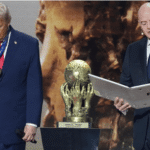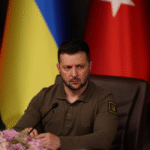The North Korea Peninsula, long a hotbed of geopolitical tensions, is once again at the center of global attention as Kim Yo Jong, the powerful sister of North Korean leader Kim Jong Un, lashed out at South Korea over its use of drones. In a fiery statement, she condemned what she described as South Korea’s “reckless provocations” and threatened a strong military response should such actions continue. This incident highlights the increasingly volatile relationship between the two Koreas, both of which are locked in a decades-long conflict with no clear end in sight.
In this article, we will explore the recent escalation in tensions triggered by the drone issue, delve into the broader context of North-South relations, analyze Kim Yo Jong’s role in North Korean politics, and assess the global implications of this ongoing conflict.
1. Kim Yo Jong’s Strong Response: A Warning to South Korea
1.1. The Drone Incident That Sparked the Fury
The latest controversy stems from an incident in which South Korean military drones were allegedly detected flying near the Demilitarized Zone (DMZ) that separates North and South Korea. According to North Korean state media, these drones were conducting surveillance operations near sensitive North Korean military installations, a claim that South Korea has neither confirmed nor denied.
Kim Yo Jong, known for her sharp rhetoric and aggressive stance, responded with a scathing statement in which she accused South Korea of “recklessly violating” North Korea’s sovereignty. She warned that any further provocations of this nature would be met with a decisive military response. “If the South continues to send drones into our airspace, we will not hesitate to shoot them down,” Kim Yo Jong declared, signaling North Korea’s willingness to escalate the situation if necessary.
1.2. Threats of Military Action
Kim Yo Jong’s statements are notable for their explicit threats of military retaliation. She indicated that North Korea is prepared to take “all necessary measures” to defend its airspace and warned that the South would “pay dearly” if it continued to provoke the North. These remarks reflect the zero-tolerance policy that North Korea has adopted when it comes to perceived incursions into its territory.
This is not the first time Kim Yo Jong has issued threats against South Korea. In previous statements, she has warned of missile tests, military drills, and even potential strikes on South Korean military targets. Her rhetoric has been consistent in portraying the South as a puppet of the United States and a key player in what Pyongyang views as Washington’s broader strategy to encircle and weaken North Korea.
2. The Role of Kim Yo Jong: Power Behind the Throne
2.1. Kim Yo Jong’s Political Influence
Kim Yo Jong has emerged as one of the most influential figures in North Korea’s ruling regime. As the younger sister of Kim Jong Un, she occupies a unique position within the country’s leadership, acting as both a trusted advisor and enforcer for her brother. Over the years, she has taken on increasingly prominent roles, particularly in matters related to South Korea and the United States.
While Kim Jong Un remains the ultimate authority in North Korea, Kim Yo Jong has been entrusted with key diplomatic and military responsibilities. Her hardline stance on inter-Korean relations and her outspoken criticism of the United States have made her a central figure in shaping North Korea’s foreign policy. Observers believe that she is instrumental in crafting the regime’s overall strategy, especially when it comes to interactions with its southern neighbor.
2.2. A Voice for North Korea’s Hardline Faction
Kim Yo Jong’s rhetoric often mirrors that of North Korea’s military and political hardliners, who advocate for a confrontational approach to both South Korea and the West. Her statements frequently emphasize the need for North Korea to remain vigilant against perceived threats, and she has called for stronger military capabilities to defend the country’s sovereignty.
Her prominence in North Korea’s political landscape has raised questions about the country’s internal dynamics. Some experts believe that Kim Yo Jong may be positioning herself as a potential successor to her brother, although there is no official indication that Kim Jong Un is planning to step down. Regardless of her future ambitions, it is clear that Kim Yo Jong wields significant power and influence within the North Korean regime.
3. The North-South Relationship: A History of Tension and Mistrust
3.1. Decades of Conflict and Division
The Korean Peninsula has been divided since the end of World War II, with North Korea (officially the Democratic People’s Republic of Korea) and South Korea (the Republic of Korea) emerging as separate entities in the aftermath of the Korean War (1950-1953). Despite an armistice that halted active combat, the two countries have remained technically at war, with the DMZ serving as a heavily fortified buffer zone between them.
Over the years, relations between the North and South have fluctuated, ranging from periods of cautious dialogue to moments of heightened tension. While there have been attempts at reconciliation—such as the historic summits between Kim Jong Un and South Korean President Moon Jae-in in 2018—these efforts have often been derailed by disagreements over military activities, nuclear weapons, and the presence of U.S. forces in South Korea.
3.2. The Impact of Recent Military Drills and Missile Tests
The latest drone incident must be understood in the broader context of recent military activities on both sides of the DMZ. South Korea, in collaboration with the United States, regularly conducts joint military exercises that North Korea views as preparation for an invasion. These drills, combined with the presence of U.S. troops in South Korea, have long been a source of tension.
In response, North Korea has conducted its own military exercises and missile tests, showcasing its growing arsenal of ballistic missiles and nuclear capabilities. In 2024 alone, North Korea has conducted several missile launches, prompting condemnation from the international community. The cycle of provocation and retaliation has created an atmosphere of mutual distrust, with both sides on high alert.
4. The Global Implications of the Drone Incident
4.1. Escalating Tensions on the Korean Peninsula
Kim Yo Jong’s fiery response to the South Korean drone incident marks yet another escalation in the already fraught relationship between North and South Korea. The drone issue, while seemingly minor in isolation, has the potential to trigger a broader military confrontation if either side miscalculates. North Korea’s threats of retaliation raise the risk of a skirmish along the DMZ or even a full-blown conflict.
The situation is further complicated by the involvement of the United States, which has a mutual defense treaty with South Korea and maintains a significant military presence in the region. Any conflict between the North and South would likely draw in the U.S., leading to a larger and more dangerous confrontation involving nuclear-armed powers.
4.2. The International Response
The international community, particularly the United States and its allies, has expressed concern over the recent escalation of tensions on the Korean Peninsula. The U.S. State Department has called for restraint and urged both North and South Korea to avoid actions that could lead to a military confrontation. However, diplomatic efforts to resolve the situation have so far been unsuccessful, with North Korea refusing to engage in meaningful dialogue.
China, North Korea’s primary ally, has also been closely monitoring the situation. While China has historically supported North Korea, it has also advocated for stability in the region and has been wary of any actions that could provoke a larger conflict. Beijing has called for calm and emphasized the need for peaceful negotiations to resolve the issues between the North and South.
5. The Future of Inter-Korean Relations
5.1. Prospects for Diplomacy
Despite the current tensions, there remains a possibility that both North and South Korea could seek to de-escalate the situation through diplomacy. Previous inter-Korean summits have demonstrated that dialogue is possible, even in the face of long-standing animosity. However, achieving meaningful progress will require both sides to make concessions, something that neither Pyongyang nor Seoul has been willing to do in recent months.
For North Korea, any diplomatic engagement is likely to be contingent on the removal of what it perceives as existential threats—namely, the U.S. military presence in South Korea and international sanctions targeting its economy. South Korea, on the other hand, insists that North Korea must first halt its missile tests and make verifiable commitments to denuclearization before serious talks can take place.
5.2. The Role of External Actors
The role of external actors, particularly the United States and China, will be crucial in determining the future of inter-Korean relations. The U.S. remains committed to defending South Korea and has shown little willingness to reduce its military presence on the peninsula. At the same time, China will continue to play a delicate balancing act, supporting North Korea while seeking to prevent a conflict that could destabilize the region.
International organizations such as the United Nations may also play a role in mediating the situation, although their influence over North Korea has historically been limited. Sanctions, while an important tool for applying pressure on the regime, have done little to change North Korea’s behavior and have instead contributed to the country’s economic isolation.
6. Conclusion: The Uncertain Path Forward
Kim Yo Jong’s sharp condemnation of South Korea over the recent drone incident has once again brought attention to the volatile situation on the Korean Peninsula. Her threats of military retaliation underscore the fragile state of inter-Korean relations and the ever-present risk of escalation. While diplomacy remains a possible path forward, the entrenched positions of both North and South Korea make it difficult to see how tensions can be resolved in the near term.
The international community must remain vigilant in monitoring the situation, as any miscalculation could lead to a dangerous and potentially catastrophic conflict. The challenge for global leaders is to find a way to navigate this perilous landscape, fostering dialogue and trust to prevent the Korean Peninsula from descending into further instability. ALSO READ:-“Russian Lukashenko Nuclear Shift Was Overdue,” Says Belarusian Leader Lukashenko 2024






скачать mostbet http://mostbet6006.ru/ .
1вин. http://1win6001.ru .
1вин официальный сайт 1вин официальный сайт .
1 win регистрация https://familyclub.borda.ru/?1-6-0-00002163-000-0-0-1743051813 .
поддержка мостбет mostbet6006.ru .
1 win официальный сайт вход https://familyclub.borda.ru/?1-6-0-00002163-000-0-0-1743051813 .
1вин официальный сайт 1вин официальный сайт .
1вин вход с компьютера http://alfatraders.borda.ru/?1-0-0-00004932-000-0-0-1743258210/ .
1win официальный https://www.alfatraders.borda.ru/?1-0-0-00004932-000-0-0-1743258210 .
1win rossvya http://www.alfatraders.borda.ru/?1-0-0-00004932-000-0-0-1743258210 .
1вин официальный сайт 1вин официальный сайт .
1win играть https://balashiha.myqip.ru/?1-12-0-00000437-000-0-0-1743258848 .
1 вин вход https://1win6049.ru .
mostbet http://svstrazh.forum24.ru/?1-18-0-00000136-000-0-0-1743260517 .
1vin pro https://www.1win6050.ru .
1-win http://1win6050.ru .
адин вин адин вин .
1win онлайн 1win онлайн .
казино онлайн kg казино онлайн kg .
один вин официальный сайт один вин официальный сайт .
1win com 1win6051.ru .
1win com http://1win6052.ru/ .
1хwin http://1win6052.ru .
Для удачного продвижения вверх по карьерной лестнице понадобится наличие диплома о высшем образовании. Заказать диплом о высшем образовании у сильной организации: rusd-diplomj.ru/diplom-ofitsialno-kupit-bistro-i-bez-lishnix-problem/
1вин rossvya https://www.1win6052.ru .
скачать мостбет официальный сайт https://www.mostbet6029.ru .
услуги хранения вещей москва услуги хранения вещей москва .
1вин приложение https://www.1win6053.ru .
1win кыргызстан https://www.1win6053.ru .
1win live https://1win6053.ru/ .
1win md https://1win5011.ru/ .
1win md 1win md .
1win.pro http://www.1win5011.ru .
1вин официальный сайт 1вин официальный сайт .
1vin kg http://1win6009.ru/ .
mostbet промокод http://mostbet6011.ru .
скачать mostbet на телефон http://mostbet6011.ru/ .
1 вин http://1win6009.ru/ .
mostber mostber .
скачать mostbet на телефон https://mostbet6012.ru .
игра 1вин https://www.1win6046.ru .
1win официальный сайт http://1win6046.ru .
1win казино 1win казино .
Заказать диплом ВУЗа!
Мы можем предложить документы ВУЗов, которые расположены в любом регионе России. Дипломы и аттестаты печатаются на бумаге высшего качества: dyado.listbb.ru/viewtopic.phpf=2&t=1391
Мы готовы предложить дипломы любой профессии по приятным ценам.– kupitediplom.ru/kupit-diplom-s-zaneseniem-v-reestr-po-nizkoj-tsene/
mostbet kg mostbet kg .
Мы изготавливаем дипломы любых профессий по приятным ценам. Купить диплом автослесаря — kyc-diplom.com/diplomy-po-professii/kupit-diplom-avtoslesarya.html
Приобрести диплом университета по невысокой стоимости можно, обращаясь к надежной специализированной фирме. Мы оказываем услуги по изготовлению и продаже документов об окончании любых университетов РФ. Заказать диплом университета– diplomc-v-ufe.ru/poluchite-diplom-visshego-obrazovaniya-s-reestrovoj-zapisyu-3/
Заказать диплом о высшем образовании!
Купить диплом института по доступной стоимости вы можете, обращаясь к проверенной специализированной фирме. Приобрести диплом: diplomk-vo-vladivostoke.ru/kupit-originalnij-diplom-s-zaneseniem-v-reestr-17
Мы изготавливаем дипломы любой профессии по выгодным ценам.
Вы покупаете документ в надежной и проверенной компании. Приобрести диплом института– http://thelspr.listbb.ru/viewtopic.phpf=13&t=1643/ – thelspr.listbb.ru/viewtopic.phpf=13&t=1643
промокод продамус на 5000 http://prodams-promokod.ru .
официальные криптовалюты официальные криптовалюты .
окна новосибирск oknasibirinsk.ru .
Мы изготавливаем дипломы любых профессий по выгодным тарифам.– jobflux.eu/employer/23095/frees-diplom
купить пластиковые окна дешево купить пластиковые окна дешево .
https://millionigrushek.ru
https://l-spb.ru
Заказать диплом любого университета мы поможем. Купить диплом о высшем образовании в Твери – diplomybox.com/kupit-diplom-o-vysshem-obrazovanii-v-tveri
монтаж натяжного потолка цена монтаж натяжного потолка цена .
For more information https://tonersklad.ru .
банкротство физ лиц банкротство физ лиц .
диплом купить в нижнем новгороде диплом купить в нижнем новгороде .
банкротство физ лиц банкротство физ лиц .
Где заказать диплом по нужной специальности?
Купить диплом ВУЗа по доступной стоимости возможно, обратившись к проверенной специализированной компании.: diplom-zakaz.ru
аквариус займ аквариус займ
банкротство физлиц https://bankrotstvo-grajdan.ru/ .
банкротство граждан bankrotstvo-grajdan.ru .
ипотека под материнский капитал crediteurasia.ru .
кредит на карту без отказа кредит на карту без отказа .
Накрутка лайков ВК 2025 Накрутка лайков ВК
Заказывал услуги проверенного хакера. КОНТАКТЫ СПЕЦИАЛИСТА:
XakVision@protonmail.com
Рекомендую xakervip.com/topic/282/page/7/ .
отзывы https://niksolovov.ru/services/dooglys 2025
купить пластиковые окна с завода http://okna177.ru .
Thanks for the article. Here is a website on the topic – https://40-ka.ru/
Thanks for the article. Here is a website on the topic – https://40-ka.ru/
Thanks for the article. Here’s more on the topic https://yarus-kkt.ru/
Thanks for the article. Here is a website on the topic – https://kanunnikovao.ru/
Thanks for the article. Here is a website on the topic – https://kanunnikovao.ru/
услуги стоматологической клиники http://www.stomatologiya-arhangelsk-1.ru .
Thanks for the article. Here’s more on the topic https://my-caffe.ru/
Хочу поделиться положительным отзывом о хакере – Также рекомендую вам почитать по теме – https://telegra.ph/Otzyv-polzovatelya-o-uslugah-hakerov-07-30-2 .
И еще вот – https://telegra.ph/Opyt-ispolzovaniya-uslug-hakerov-otzyv-polzovatelya-07-30-2 .
Thanks for the article https://40-ka.ru/
Рекомендую – https://med-like.ru/kak-nachat-uspeshnuyu-kareru-v-eskort-uslugah-s-agentstvom-rubus24-polnoe-rukovodstvo/
ушп фундамент под ключ цена московская область .
Thanks for the article https://community.wongcw.com/blogs/1095361/The-RybachOK-website-is-a-reliable-choice-for-everyone?btwaf=12835090 .
Thanks for the article https://odessamama.net/forum.php?mod=viewthread&tid=288351&extra= .
Website https://amurplanet.ru/ .
Website https://photo-res.ru/ .
Website https://portalbook.ru/arenda-avtomobilya-dlya-povsednevnyh-zadach-i-poezdok-po-gorodudlya-povsednevnyh-zadach-i-poezdok-po-gorodu/
промокоды на сегодня
En esta clínica urológica moderna se reúne la información esencial para hombres que cuidan su salud.
Si quieres entender en qué consiste una consulta de urología, entra en la Clínica de Urología Moderna y revisa sus servicios.
Toda la información sobre tratamientos mínimamente invasivos la ofrece la Clínica de Urología Moderna con un lenguaje sencillo.
лучшие экскурсии по рекам и каналам Санкт-Петербурга
лучшие отели в Риме